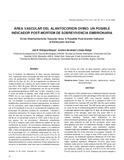Mostrar el registro sencillo del ítem
Área vascular del alantocorion ovino: un posible indicador post-mortem de sobrevivencia embrionaria
| dc.rights.license | http://creativecommons.org/licenses/by-nc-sa/3.0/ve/ | |
| dc.contributor.author | Rodríguez Márquez, José | |
| dc.contributor.author | Hernández, Aureliano | |
| dc.contributor.author | Hidalgo Delgado, Gladys | |
| dc.date.accessioned | 2009-05-18T20:06:13Z | |
| dc.date.available | 2009-05-18T20:06:13Z | |
| dc.date.issued | 2009-05-18T20:06:13Z | |
| dc.identifier.issn | 0798-2259 | |
| dc.identifier.uri | http://www.saber.ula.ve/handle/123456789/28285 | |
| dc.description.abstract | Con la finalidad de determinar el área vascular alantoidea (AV), expresada como porcentaje del área total del conceptus ovino de gestaciones normales (GN) y múltiples inducidas (GMI) en los días 20, 28 y 35 de la gestación, se utilizaron 24 ovejas divididas en 2 grupos con igual número de ovejas cada uno (GN y GMI). El grupo GMI fue sincronizado con esponjas colocadas en la vagina e impregnadas con 60 mg de acetato de medroxyprogesterona (AMP) por 13 días. Cuarenta y ocho h. antes de retirar la esponja, cada oveja recibió 1500 UI de PMSG vía i.m. Las ovejas de GN una vez que presentaron el tercer celo fueron servidas por un carnero entero (monta natural). Los animales se sacrificaron en las edades de gestación establecidas, obteniendo los tractos reproductivos, se removieron los conceptus, para luego tomarles fotografías y determinar el AV mediante el uso de un analizador de imágenes computarizado. Se aplicaron pruebas de correlación, t-Student y estadística descriptiva. En ningún caso el AV superó el 8% del total de área del conceptus. Sin embargo, aumentó drásticamente en un porcentaje cercano al 100% cada 8 días en ambos grupos. No se encontraron diferencias estadísticas (P>0,05) a ninguna edad entre embriones viables de las dos condiciones de preñez. Se encontraron diferencias altamente significativas (P<0,01) entre embriones viables y no viables en GMI, y hubo una asociación positiva altamente significativa entre el porcentaje AV y la viabilidad embrionaria los días 20, (r=0,78; P<0,01); 28 (r=0,90; P<0,01) y 35 (r=0,91; P<0,01). El embrión puede sobrevivir con un AV escasa antes del día 35 de gestación (los promedios fluctuaron entre 1,67 y 7,03%). Independientemente de cuándo comienza el flujo sanguíneo funcional en la alantoides, está claro que la mortalidad embrionaria en ovinos, así como en otras especies, parece asociada con fallas en la vascularizacion alantoidea. Siendo así, el AV podría ser usado como una medida válida para determinar la viabilidad embrionaria post-mortem. | es_VE |
| dc.rights | info:eu-repo/semantics/openAccess | |
| dc.subject | Ovejas | es_VE |
| dc.subject | Área vascular | es_VE |
| dc.subject | Alantocorion | es_VE |
| dc.subject | Mortalidad embrionaria | es_VE |
| dc.title | Área vascular del alantocorion ovino: un posible indicador post-mortem de sobrevivencia embrionaria | es_VE |
| dc.title.alternative | Ovine allantochorionic vascular area: a possible post-mortem indicator of embryonic survival | es_VE |
| dc.type | info:eu-repo/semantics/article | |
| dc.description.abstract1 | The objective of this research was to determine allantoids vascular area (VA), expressed as the percentage of the total area of ovine conceptus in normal (NP) and induced multiple (IMP) pregnancies on days 20, 28 and 35 of gestation. A total of 24 ewes divided into 2 groups (NP and IMP) with the same number of animals in each were used. The IMP group was synchronized by using 60 mg of medroxyprogesterone acetate (MPA) soaked in sponges placed in the vagina for 13 days. At 48 hours before withdrawal of the sponges, each ewe was given 1500 IU of PMSG, i.m. Ewes were bred in their third heat period with a ram (natural breeding). Animals were euthanized at the above-mentioned gestational ages; afterwards their reproductive tracts were removed as well as the conceptus, which were photographed and their VA determined through a digital image analyzer. Data was analyzed using descriptive statistics, t-Student tests and correlation coefficient determination. VA was not greater than 8% of the total area of conceptus. However, AV increased drastically to a range of near 100% every 8 days in both groups. No statistically significant differences (P<0.05) were found at any age between viable embryos from both groups. Highly statistical significant differences (P<0.01) were found between viable and non viable embryos from the IMP group, and there was a highly significant positive association between AV and embryonic viability on days 20, (r=0.78; P<0.01); 28 (r=0.90; P<0.01) and 35 (r=0.91; P<0.01). Embryos can survive despite a scarce AV before day 35 of pregnancy (means range from 1.67 to 7.03%). Independent of when functional blood flow starts in the allantoids, it is clear that embryonic mortality in sheep, as well as in other species, seems to be associated with a failure in allantoids vascularization. Thus, AV could be used as an accurate measurement to determine embryonic viability in post mortem evaluations. | es_VE |
| dc.description.colacion | 14 - 19 | es_VE |
| dc.description.frecuencia | Bimestral | |
| dc.identifier.depositolegal | 199102ZU46 | |
| dc.subject.institucion | Universidad del Zulia (LUZ) | es_VE |
| dc.subject.institucion | Universidad de Los Andes (ULA) | es_VE |
| dc.subject.keywords | Sheep | es_VE |
| dc.subject.keywords | Vascular area | es_VE |
| dc.subject.keywords | Allantochorionic | es_VE |
| dc.subject.keywords | Embryonic survival | es_VE |
| dc.subject.publicacionelectronica | Revista Científica | |
| dc.subject.tipo | Revistas | es_VE |
| dc.type.media | Texto | es_VE |
Ficheros en el ítem
Este ítem aparece en la(s) siguiente(s) colección(ones)
-
Revista Científica - 2005 - Vol XV - No. 001
enero - febrero



